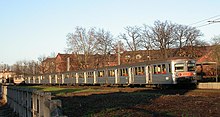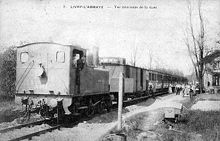Line 4 of the Paris tram
The line 4 tram Ile-de-France was put into operation on November 20 of 2006. This is the first opening of a so-called tram-train line in France. The route is outside the Paris metropolitan area in the Seine-Saint-Denis department . The trams used run on a railway superstructure and are the only ones in the world that run with a contact line voltage of 25 kV at a frequency of 50 Hz.
History of the route
The route as a railway line

The route between the stations Aulnay-sous-Bois and Bondy was in 1875 as a link between two main tracks of the companies of the Chemins de fer de l'Est Compagnie (EST) and Compagnie des du Nord chemins de fer (NORD) built that of Paris led out to the east and north. In August of that year, the Compagnie du chemin de fer de Bondy à Aulnay opened the southern section from Bondy on the Paris – Strasbourg line to Gargan , and the following month the line from Gargan to Aulnay ( La Plaine – Hirson line ). The original purpose of the building was to facilitate the removal of wood and plaster as well as the transport of eggs and poultry to Paris. The colloquial term "Ligne des Coquetiers" results from this.
Initially, the eight-kilometer, standard-gauge line was single-track with only three train stations. In 1880, the state bought the troubled railway company and handed over operations to EST, which in 1883 became the owner of the line. In 1913, the EST laid a second track on the four-kilometer southern section, and the line remained single-track between Gargan and Aulnay. In May 1962 - the railway companies had been nationalized since 1938 - the SNCF equipped the southern section with an overhead line for 25 kV AC voltage . The northern section, which continues to be single-track, was initially reserved for diesel railcars for shuttle traffic between Gargan and Aulnay, and was not electrified until September 1977.
Due to the single track, the northern section only allowed operation for 30 minutes. On the double-track line from Gargan to Bondy, electric locomotives of the BB 16500 series ran every 15 minutes with "Inox" passenger cars, which were tied through to the Gare de l'Est during peak times . The high train frequency increasingly impaired road traffic. The fourteen level crossings usually had no separate waiting lanes for vehicles due to a lack of space, so that when the railway barriers were closed, all traffic was blocked. Therefore, lowering the railway line was discussed in the 1970s, but was discarded for reasons of cost.
The Est Ouest Liaison Express (Eole) project put an end to direct trains to the Gare de l'Est in the 1990s. With the opening of line E of the S-Bahn- like Réseau express régional d'Île-de-France (RER) in 1999, there were no longer any free timetable routes for trains from the “Ligne des Coquetiers” there . From then on they only commuted between Bondy and Aulnay, which made the route less attractive and the load factor sank to less than 10,000 passengers per day. The problem of numerous level crossings and the associated impairment of road traffic remained. The last regular passenger trains ran on December 14, 2003, and were replaced by buses the following day .
Tram operation
In 2000, planning began for a redesign of the route. The primary goal was to replace the barrier level crossings with other solutions. The tram-train was ideal for this purpose , the trains of which, based on the model of the Karlsruhe Stadtbahn , can run as trams in the street as well as on railway lines. As a tramway (on its own route - here the old railway line), he may, as such, roads to normal traffic signal crossing (traffic lights). The preliminary studies were completed in 2003 and officially approved after the SNCF had put the construction of the vehicles out to tender across Europe in 2001.
The renovation work began in June 2004, with the substructure being renovated and the superstructure renewed. The platforms were rebuilt to match the widths and heights of the wagons, and the line was expanded to double-track throughout. The single-track reinforced concrete bridge over Route nationale 3 in Gargan from 1932 was replaced by a new construction, and a second bridge was added parallel to the first over the Canal de l'Ourcq . The contact line systems and the alternating voltage of 25 kV were retained.
Today's route is 7.9 kilometers long, has eleven stops - three of which are new - and connects six communities . In contrast to the earlier railway operations, the trams run on the right . The permitted speed is 70 km / h, in built-up areas it is limited to 50 km / h and at intersections to 30 km / h. Despite the additional stops, the travel time between the end points remained unchanged at 20 minutes, which can be attributed to the better acceleration and braking capabilities as well as the faster passenger change due to the low-floor technology .
The official commissioning of line T4 was on November 18, 2006. In Aulnay-sous-Bois there is a connection to the RER B line , in Bondy to the RER E line .
Stops
| Tram line T 4 | |||
|---|---|---|---|
| station | Parish (noun) | connection | |
| Aulnay-sous-Bois | Aulnay-sous-Bois |
|
|
| Rougemont - Chanteloup | Sevran, Aulnay-sous-Bois | ||
| Freinville - Sevran | Sevran | ||
| L'Abbaye | Livry-Gargan | ||
| Lycée Henri Sellier | Livry-Gargan | ||
| Gargan | Les Pavillons-sous-Bois | ||
| Les Pavillons-sous-Bois | Le Raincy , Les Pavillons-sous-Bois | ||
| Allée de la Tour - Rendez-Vous | Villemomble | ||
| Les Coquetiers | Villemomble | ||
| Remise à Jorelle | Bondy | ||
| Bondy | Bondy |
|
|
| Route of the tram line T 4 >>> | |||
Crossing with Avenue Victor Hugo at the north end of the three-track Gargan station, in the background the bridge over the RN 3
Bondy station, continuing the operating track to the railway network
particularities
In contrast to the other tram lines, the T4 line is not operated by the local transport company RATP , but by the SNCF railway company, which can be recognized by the blue color of the trains (RATP: light green / white). The trains run on a railway superstructure and at the usual rail voltage of 25 kV with a frequency of 50 Hz in the north-east of the country; the option of running under DC voltage has not yet been used. In addition, the trains run on sight and therefore not covered by signals in the space between them.
In this context, the SNCF created a new occupation for the deployment of drivers on tram trains: the conductor tram train (CRTT) is trained to drive traction vehicles on railway lines as well as in road space.
Vehicle fleet

For use on this route, SNCF has acquired 15 articulated tram cars of the Avanto S 70 type from the German manufacturer Siemens, which are classified as the U 25500 series in the SNCF vehicle diagram. The depot and workshop are located in Noisy-le-Sec .
With the planned branch line to Montfermeil, additional vehicles will be required. In January 2016, SNCF therefore ordered 15 Citadis Dualis wagons from Alstom. Delivery is scheduled to begin in October 2017. The vehicles are to be used from 2019.
Planned new route Gargan – Montfermeil
A new branch of this tram caters to the mobility needs of the residents of Les Pavillons-sous-Bois , Livry-Gargan , Clichy-sous-Bois and Montfermeil . It creates fast connections to the RER lines E and B and later to the Clichy-Montfermeil and Bondy stations of the Grand Paris Express project .
This new line is part of the development program for public transport in the eastern part of the Ile-de-France , which also includes the planned T Zen 3 express bus line between Porte de Pantin and Gargan , the extension of the T1 tram line to Val de Fontenay station and the construction of the Tangential Nord to belong to Noisy-le-Sec .
The plans include a 6.5 km long branch line that branches off the existing line to the east in Gargan. There are 11 stops. Montfermeil is driven through in a long, single-track turning loop with a total of 4 stops. Around 37,000 passengers are expected on average each day.
A main line from Bondy to Gargan will be created, which will be used by all trains in the direction of Aulnay and Montfermeil. On this the train sequence between 6:00 and 20:00 will be three minutes, on the north or east branch it will be six minutes. The new line will be built according to tram guidelines. The contact line carries 750 V direct voltage in this branch.
The construction costs are given at approx. 214 million euros. The STIF bears the costs for the rolling stock . The use of Citadis-Dualis trains from Alstom is planned , for which around 60 million euros are estimated. The start of construction was initially planned for 2014; commissioning towards the end of 2017. But civil engineering work could not begin until autumn 2016. The completion of the new line is now planned for 2018 and the line will not be released until 2019.
Remarks
- ↑ Coquetier = poultry dealer
Web links
- Opening of the T4 line (photos)
- The fin de la ligne des Coquetiers. (No longer available online.) Archived from the original on December 26, 2013 ; accessed on May 9, 2017 . (French)
literature
- Jean Tricoire: Le tramway à Paris et en Île-de-France . Éditions La Vie du Rail, Paris 2007, ISBN 978-2-915034-66-0 , p. 127 ff .
Individual evidence
- ^ Jean Tricoire: Le tramway à Paris et en Île-de-France . Éditions La Vie du Rail, Paris 2007, ISBN 978-2-915034-66-0 , p. 127 .
- ^ Jean Tricoire: Le tramway à Paris et en Île-de-France. 2007 edition, p. 130.
- ↑ International Railway Journal of January 5, 2016: SNCF orders tram-trains for Paris Line T4 (English) accessed on January 20, 2016
- ↑ La nouvelle branche du tramway T4 déclarée d'utilité publique ( Memento of June 11, 2015 in the Internet Archive ) STIF 2013 message (French) accessed November 4, 2013.
- ↑ http://www.stif.org/IMG/pdf/Dossier_de_Presse_T4.pdf Press release STIF 2012 (French) accessed November 4, 2013.
- ↑ mobilicites.com of October 19, 2016: Seine-Saint-Denis: le tram Clichy-sous-Bois Montfermeil franchit une ultime étape (French); accessed on October 20, 2016











